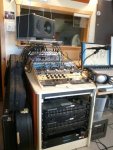I've just committed to buying a modest 32 channel console (Tascam M-3500) for my studio, an upgrade from a 16 channel board. In my efforts to take a 'pro' approach to setting up my studio I have 6 or so 48 point, 1/4" patchbays. (As you may know, a 48 point patchbay means you have two rows of 24 points (places to plug gear it), one on top of the other in a 1U rack space.) I'm quite happy with 1/4" patchbays instead of the higher end tt patchbays but it does leave me in a bit of a quandary.
With 32 inputs, 32 tapes returns, 32 inserts and 32 Direct Outs to wire (among many... many other items), should I do two patchbays side by side to keep things neat and clear with all like items in one row, or do a single column of patchbays with like items being forced down into the next patch bay? (ie: One patch bay would handle, for instance, Lines 1-24 and the second would handle 25-32, should I put that second bay to the right of the first, or below it.)
I'm inclined to setup the patchbays side by side, but the resulting 40" wide patch field may seem to visually heavy. I know it's a personal preference thing but I'm still curious about what others would do. Mentally, keeping like items in a long row would be easier to keep straight for me.
(As a side note, I'm moving my studio to a new location and am going to be undertaking a substantial construction project to enclose and build a new space, so needing to make physical modifications to accommodate the patchbays isn't an issue... so long as I make the choice now. )
)
Any input is welcome!
With 32 inputs, 32 tapes returns, 32 inserts and 32 Direct Outs to wire (among many... many other items), should I do two patchbays side by side to keep things neat and clear with all like items in one row, or do a single column of patchbays with like items being forced down into the next patch bay? (ie: One patch bay would handle, for instance, Lines 1-24 and the second would handle 25-32, should I put that second bay to the right of the first, or below it.)
I'm inclined to setup the patchbays side by side, but the resulting 40" wide patch field may seem to visually heavy. I know it's a personal preference thing but I'm still curious about what others would do. Mentally, keeping like items in a long row would be easier to keep straight for me.
(As a side note, I'm moving my studio to a new location and am going to be undertaking a substantial construction project to enclose and build a new space, so needing to make physical modifications to accommodate the patchbays isn't an issue... so long as I make the choice now.
 )
)Any input is welcome!


 as it turned out, those closest tot he floors got used the least... and even those near the top of the rack (just below the desktop) saw some use... but overtime, I reached for what was easiest to get to. And despite my seemingly well thought out location of patchbays and gears I still found myself needing longer cables to patch something on the left side to something on the right.
as it turned out, those closest tot he floors got used the least... and even those near the top of the rack (just below the desktop) saw some use... but overtime, I reached for what was easiest to get to. And despite my seemingly well thought out location of patchbays and gears I still found myself needing longer cables to patch something on the left side to something on the right.